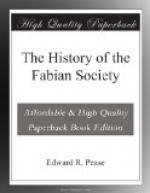The suggestion was made in March, 1911, by Henry H. Slesser, then one of the younger members of the Executive, that the friendly relations of the two bodies should be further cemented by the formation of a Joint Standing Committee. Four members of each Executive together with the secretaries were appointed, and W.C. Anderson, later M.P. for the Attercliffe Division of Sheffield, and at that time Chairman of the I.L.P., was elected Chairman, a post which he has ever since retained. The Joint Committee has wisely confined its activities to matters about which there was no disagreement, and its proceedings have always been harmonious to the verge of dullness. The Committee began by arranging a short series of lectures, replacing for the time the ordinary Fabian meetings, and it proposed to the Labour Party a demonstration in favour of Adult Suffrage, which was successfully held at the Royal Albert Hall.
In the winter of 1912-13 the Joint Committee co-operated with the National Committee for the Prevention of Destitution (of which later) in a big War against Poverty Campaign, to demand a minimum standard of civilised life for all. A demonstration at the Albert Hall, a Conference at the Memorial Hall, twenty-nine other Conferences throughout Great Britain, all attended by numerous delegates from Trade Unions and other organisations, and innumerable separate meetings were among the activities of the Committee. In 1913 a large number of educational classes were arranged. In the winter of 1913-14 the I.L.P. desired to concentrate its attention on its own “Coming of Age Campaign,” an internal affair, in which co-operation with another body was inappropriate. A few months later the War began and, for reasons explained later, joint action remains for the time in abeyance.
It will be convenient to complete the history of the movements for Socialist Unity, though it extends beyond the period assigned to this chapter, and we must now turn back to the beginning of another line of action.
The International Socialist and Trade Union Congresses held at intervals of three or four years since 1889 were at first no more than isolated Congresses, arranged by local organisations constituted for the purpose in the preceding year. Each nation voted as one, or at most, as two units, and therefore no limit was placed on the number of its delegates: the one delegate from Argentina or Japan consequently held equal voting power to the scores or even hundreds from France or Germany. But gradually the organisation was tightened up, and in 1907 a scheme was adopted which gave twenty votes each to the leading nations, and proportionately fewer to the others. Moreover a permanent Bureau was established at Brussels, with Emile Vandervelde, the distinguished leader of the Belgian Socialists, later well known in England as the Ministerial representative of the Belgian Government during the war, as Chairman. In England, where the Socialist and Trade Union forces were divided,




